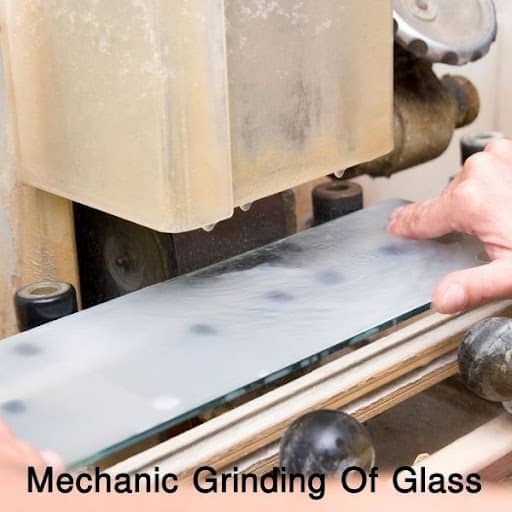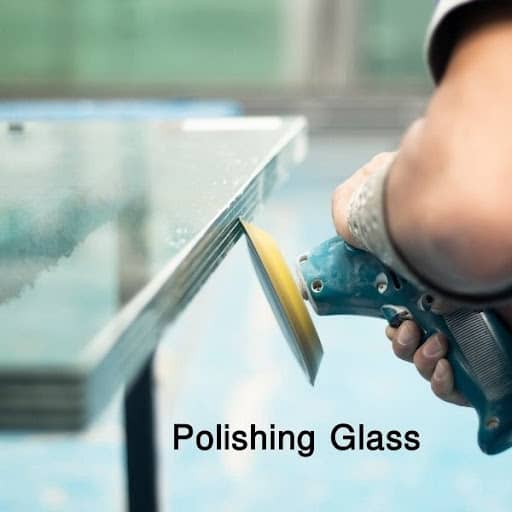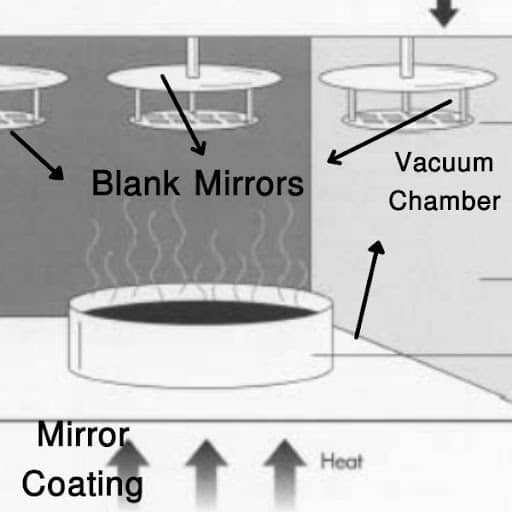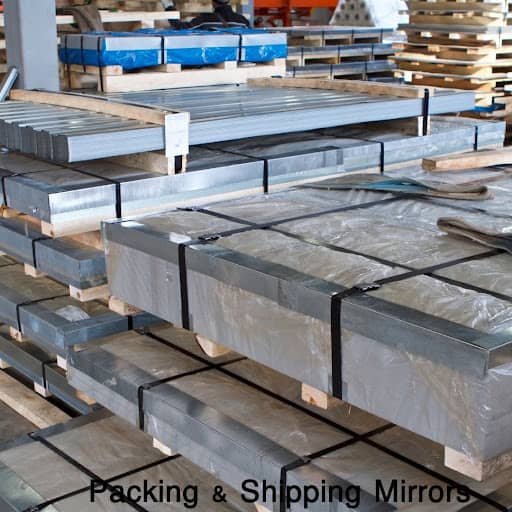The mirror that we daily use has to pass many phases before coming into our hands. The need for a mirror arises when people love seeing their reflection in the water. The first mirror was made by polishing the surface of metals.
The invention of the silvering process in 1600 BC was the initial step to starting mirror production on an industrial scale. However, the quality of the image in the old mirror was not as good as we see today.
In this post, we’re going to cover the material needed to make the mirror and the manufacturing process of the mirror.
What are mirrors made of? Overall mirror contains 90% of glass and 10% of silvering material. It is made up of glass, flat or curved. To convert this glass into a mirror, a reflective coating is applied to it. The metals used for reflective coating are silver and aluminum.
The composition of mirrors varies with its application. It is not a piece of glass used for looking through. It has wide application in optical instruments like telescopes.
What Material Is Mirror Made Up of
What type of material is used in the composition of mirrors? In mirror composition glass plays a vital role, about 99 % of total ingredients. To convert glass into a mirror, it is covered with reflective coating from one side. This coating material consists of aluminum or silver metal. Silver nitrate is mainly used as a silvering compound.
The glass is coated with a thin film of metallic silver or aluminum. This film helps mirrors to reflect light and show images in it. People used to see their reflection in water before the invention of mirrors.
What Is The Raw Material of a Mirror
First of all the major component is Glass. However, it is a poor reflector of light and can reflect only 4% of the light falling on it. It is made up of natural crystals of silica or quartz. Nowadays you can buy synthetic glass as well.
The second most important raw material is Silvering substance or Silvering metal. For this, gold, aluminum, silver, and chrome are widely used. Depending on the application and desired reflective ability of customers, the metals for silvering are selected.
For dielectric coating or scientific-grade coating materials like silicon oxide and silicon, nitrides are used. Modern mirrors mostly come with this type of courting as it is scratch-resistant and more protective against corrosion.
How Mirror is Made: Step By Step Process
The manufacturing of mirrors involves complex procedures. Unlike glass, it requires a few additional steps to make the glass surface reflective to light. The initial steps involve cutting and reshaping glass. After this, the piece of glass is passed through an optical grinding machine to produce smooth blanks. The last step involves the coating of reflective material and evaporation.
#Step-1: Cutting and Sizing of Glass
The cutting and sizing of glass mainly depend on the application of mirrors. For automotive mirrors, house mirrors, and decorative mirrors different cutting tools are used. For large-scale cutting diamonds, saws are used. For cutting and edging small size mirrors sharp pointed blades are used.

#Step-2: Optic Mechanic Grinding
After cutting glass, it is passed through an optic grinding machine. This machine gives the desired surface shape to the glass sheets as convex, concave, or flat. This gritty liquid is spread over the glass sheets and is rolled through scribes to make the sheets smooth and even. Hand grinding techniques are also used for small size glass.

#Step-3: Polishing the Blanks
Inside the mechanical grinder, 50 to 100 sheets of glass are polished simultaneously. That’s why mechanical grinding is more efficient than manual grinding. It requires a lot of time to polish each glass sheet separately if you don’t have a mechanical grinder for this purpose.

#Step-4: Coating with Reflective material
After grinding, sheets are passed through coating material to increase the reflective power of glass. This process takes place in an evaporator. It has a large metal plate to hold glass sheets and a crucible to melt the coating material. It is then applied to sheets.

#Step-5: Design the mirror
Now it’s time to pattern the mirror according to its application. Metal stencils and masks are used to create a different pattern on the mirror surface according to the customer’s demand.
#Step-6: Dielectric Coating
To protect the reflecting layer from rust, the dielectric coating is applied. It increases the durability of the mirror. It also helps to change the reflective and dielectric properties of mirrors used. For this purpose, silicon oxides and silicon nitrides are used as dielectric coatings. These gases along with heat form a solid metal-like coating on the mirror surface.
#Step-7: Evaporation
To make multiple coatings, evaporation is carried out. For this clear dielectric, metal is evaporated on the top of the metal. For already silvered mirrors, an opaque layer is applied to improve reflectivity.
#Step-8: Packing
Now the mirror is ready to pack carefully and ship to desired places. Remember this process involves many hazardous procedures. So, don’t try it at home. It needs a separate studio as glass is a sharp object that may hurt kids and pets.

Which Metal Is Used For Making a Mirror
What metal is a mirror made of? Mirror itself is made up of glass. When it comes to coating for reflection, glass needs a metallic layer. For this purpose silver and aluminum are commonly used metals. Silver stands first because it reflects 95% of the light that falls on it. With time, silver got expensive. So, its best alternative is aluminum coating. Still, in mirrors for telescopes, the silver coating is used for better accuracy.
Aluminum is a bit less reflective as compared to silver. But it can also reflect 90% of the light falling on it. The durable coating is of course silver. Due to its high cost, nowadays aluminum coating is getting more popular.
What Minerals Are Mirrors Made of
The mirror includes three minerals in its composition, feldspar, silica, and silver. Silica is present in the main component of the mirror, Glass. IT is found in sand, crystalline, clay, and granite. Feldspar contains calcium, sodium, potassium, and barium. It comes from rock or magma. It is a group of rock-forming aluminum tectosilicate minerals. Silver is used in coating glass to make it reflective. The layer of metallic silver is deposited on glass through a chemical reaction to make it better reflective of light.
What is An Acrylic Mirror Made of
Acrylic mirror is made up of acrylic sheets, not glass sheets. Acrylic is a form of plastic that is transparent in color. It is foldable and much lighter than a glass mirror. In order to turn transparent acrylic sheets into mirrors, a thin film of reflective silver laminate is applied on its back.
Nowadays acrylic mirrors are rapidly displacing glass mirrors. The reason is that they are unbreakable, light in weight, and easy to cut and fold. The use of acrylic mirrors is increasing in furniture and home decor accessories.
How Mirrors are Made | History of Mirrors from 8,000 BC to Modern Day
Frequently Asked Questions
Are Mirrors Made of Sand?
The main ingredient of mirrors is glass and sand is directly involved in its preparation. The first glass is prepared out of silica derived from sand. After this, glass is converted into a mirror by deposition of a thin layer of silver or aluminum.
If you take a handful of grit sand, you can see it looks shiny as a mirror. So, the mirror has qualities of sand as both shine when light falls on it.
How Are Mirrors Made Today?
Modern mirrors are made in a vacuum by heating aluminum. It is then cooled to bond up in a glass. The silvering of modern mirrors is much easier than contemporary ones. It is done by spraying a thin film of silver or aluminum on the back of a glass sheet.
Thanks to technology, now you can see the wide application of mirrors. It is used in the protection of electric appliances such as LEDs. IT is available in different sizes and thicknesses.
Why is a Mirror Made of Glass?
Almost 99% of mirrors are made up of glass. The reason is that glass is the most durable material to convert into a mirror. Other options are plastic and metal. If mirrors were made from plastic, they were likely to scratch easily. Similarly, mirrors can’t be made with metal as they would be costly and heavy.
Below are some more reasons for choosing a glass to make a mirror:
- Glass is a cheaper material than others
- Glass is easy to cut, mold, and resize
- Silvering glass is easier as compared to plastic
- It is scratch-free and optically opaque
Final Words
To summarize, the manufacturing mirror is not a Do-It-Yourself procedure. It starts with preparing and sizing glass. After cutting, a thin layer of silvering metal is deposited on it. The whole process is carried out in a vacuum under strict temperature control.
If we list metals and minerals involved in mirror composition, we may also list the minerals involved in the composition of glass. As glass is the main ingredient of mirrors.

